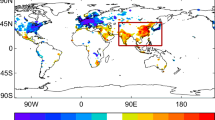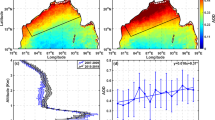Abstract
While some long breaks of monsoon intraseasonal oscillations (MISOs) are followed by active spells (BFA), some others are not (BNFA). The circulation during BFA (BNFA) cases helps (prevents) accumulation of absorbing aerosols over central India (CI) resulting in almost three times larger Aerosol Index (AI) over CI, during BFA cases compared to BNFA cases. A seminal role played by the absorbing aerosols in the transition from break to active spells is unraveled through modification of the north–south temperature gradient at lower levels. The meridional gradient of temperature at low level (∆T) between aerosol-rich CI and pristine equatorial Indian Ocean is large (>6°C) and sustains for long time (>10 days) during BFA leading to significant moisture convergence to CI. The stability effect arising from surface cooling by the aerosols is overcome by the enhanced moisture convergence creating a moist static unstable atmosphere conducive for the large-scale organized convection over the CI region leading to the resurgence of active spells. The moisture convergence induced by ∆T was also able to overcome possible aerosol indirect effect (Twomey effect) and initiate deep convection and transition to active condition. During BNFA cases, however the maximum ∆T, which was weaker than the BFA cases by more than 1.5°C, could not sustain required moisture convergence and failed to lead to a sustained active spell. Using data from MODIS (MODerate resolution Imaging Spectroradiometer) onboard Terra and several other input parameters from various satellites for the period 2000–2009, the aerosol induced radiative forcing representative of two regions—the CI to the north and the pristine ocean to the south—were estimated and support the differences in observed ∆T during the two cases. Our results highlight the need for proper inclusion of absorbing aerosols in dynamical models for simulation of the observed variability of MISOs and their extended range prediction.










Similar content being viewed by others
References
Babu SS, Satheesh SK, Moorthy KK (2002) Aerosol radiative forcing due to enhanced black carbon at an urban site in India. Geophys Res Lett 29(18):1880. doi:10.1029/2002GL015826
Bhawar RL, Devara PCS (2010) Study of successive contrasting monsoons (2001–2002) in terms of aerosol variability over a tropical station Pune, India. Atmos Chem Phys 10:29–37
Bollasina M, Nigam S, Lau K-M (2008) Absorbing aerosols and summer monsoon evolution over south Asia: an observational portrayal. J Clim 21:3221–3239
Chakraborty A, Satheesh SK, Nanjundiah RS, Srinivasan J (2004) Impact of absorbing aerosols on the simulation of climate over the Indian region in an atmospheric general circulation model. Ann Geophys 22:1421–1434
Charlson RJ, Schwartz SE, Hales JM, Cess RD, Coakley JA, Hansen JE, Hofmann DJ (1992) Climate forcing by anthropogenic aerosols. Science 255:423–430
Chattopadhyay R, Sahai AK, Goswami BN (2008) Objective identification of nonlinear convectively coupled phases of monsoon intraseasonal oscillation: implications for prediction. J Atmos Sci 65:1549–1569
Collier JC, Zhang GJ (2009) Aerosol direct forcing of the summer Indian monsoon as simulated by the NCAR CAM3. Clim Dyn 32:313–332. doi:10.1007/s00382-008-0464-9
d’Almedia GA, Koepke P, Shettle EP (1991) Atmospheric aerosols: global climatology and radiative characteristics. Deepak Publishing, Hampton
Devara PCS, Raj PE, Pandithurai G, Dani KK, Maheskumar RS (2003) Relationship between lidar-based observations of aerosol content and monsoon precipitation over a tropical station, Pune, India. Meteorol Appl 10:253–262
Goswami BN (2005) South Asian monsoon. In: Lau WKM, Waliser DE (eds) Intraseasonal variability in the atmosphere-ocean climate system, chap 2, pp 19–61
Goswami BN, Ajaya Mohan RS (2001) Intraseasonal oscillations and interannual variability of the Indian summer monsoon. J Clim 14:1180–1198
Goswami BN, Xavier PK (2003) Potential predictability and extended range prediction of Indian summer monsoon breaks. Geophys Res Lett 30(18):1966. doi:10.1029/2003GL017810
Goswami BN, Ajaya Mohan RS, Xavier PK, Sengupta D (2003) Clustering of low pressure systems during the Indian summer monsoon by intraseasonal oscillations. Geophys Res Lett 30(8):1431. doi:10.1029/2002GL016734
Gruber A, Kruger AF (1984) The status of the NOAA outgoing longwave radiation dataset. Bull Am Meteorol Soc 65:958–962
Holton JR (2004) An introduction to dynamic meteorology. Elsevier, USA
Hsu NC, Herman JR, Gleason JF, Torres O, Seftor CJ (1999) Satellite detection of smoke aerosols over a snow/ice surface by TOMS. Geophys Res Lett 26:1165–1168. doi:10.1029/1999GL900155
Huffman GJ, Adler RF, Morrissey M, Bolvin DT, Curtis S, Joyce R, McGavock B, Susskind J (2001) Global precipitation at one-degree daily resolution from multi-satellite observations. J Hydrometeorol 2:36–50
Jai Devi J, Tripathi SN, Gupta T, Singh BN, Gopalakrishnan V (2010) Aerosol radiative impacts over Indian CTCZ region: results from pilot 2008 aircraft experiment. In: Proceedings of Indian Aerosol Science and Technology Association (IASTA-2010), pp 363–364
Jayaraman A (2001) Aerosol radiation cloud interactions over the tropical Indian Ocean prior to the onset of the summer monsoon. Curr Sci 81(11):1437–1445
Jones C, Carvalho LMV, Higgins RW, Waliser DE, Schemm K-KE (2004) A statistical forecast model of tropical intraseasonal convective anomalies. J Clim 17:2078–2095
Joseph S, Sahai AK, Goswami BN (2009) Eastward propagating MJO during boreal summer and Indian monsoon droughts. Clim Dyn 32:1139–1153. doi:10.1007/s00382-008-0412-8
Kalnay E, Kanamitsu M, Kistler R, Collins W, Deaven D, Gandin L, Iredell M, Saha S, White G, Woollen J, Zhu Y, Chelliah M, Ebisuzaki W, Higgins W, Janowiak J, Mo KC, Ropelewski C, Wang J, Leetmaa A, Reynolds R, Jenne R, Joseph D (1996) The NCEP/NCAR 40-year reanalysis project. Bull Am Meteorol Soc 77:437–471
Koepke P, Hess M, Schult I, Shettle EP (1997) Global aerosol dataset. Max-Plank-Institut für Meteorologie Report 243, 44 pp
Lau K-M, Kim K-M (2006) Observational relationships between aerosol and Asian monsoon rainfall, and circulation. Geophys Res Lett 33:L21810. doi:10.1029/2006GL027546
Lau K-M, Kim MK, Kim KM (2006) Asian summer monsoon anomalies induced by aerosol direct forcing: the role of the Tibetan Plateau. Clim Dyn 26:855–864
Maloney ED, Hartmann DL (2000) Modulation of eastern north Pacific hurricanes by the Madden–Julian Oscillation. J Clim 13:1451–1460
McClatchey RA, Fenn RW, Selby JEA, Volz FE, Garing JS (1972) Optical properties of the atmosphere, 3rd edn. Environ Res Pap 411:108. AFCRL-72-0497
Meehl GA, Arblaster JM, Collins WD (2008) Effects of black carbon aerosols on the Indian monsoon. J Clim 21:2869–2882. doi:10.1175/2007JCLI1777.1
Menon S (2004) Current uncertainties in assessing aerosol effects on climate. Annu Rev Environ Resour 29:1–30. doi:10.1146/annurev.energy.29.063003.132549
Menon S, Hansen JE, Nazarenko L, Luo Y (2002) Climate effects of black carbon aerosols in China and India. Science 297:2250–2253. doi:10.1126/science.1075159
Mo KC (2001) Adaptive filtering and prediction of intraseasonal oscillations. Mon Weather Rev 129:802–817
Pandithurai G, Pinker RT, Takamura T, Devara PCS (2004) Aerosol radiative forcing over a tropical urban site in India. Geophys Res Lett 31:L12107. doi:10.1029/2004GL019702
Pandithurai G, Dipu S, Dani KK, Tiwari S, Bisht DS, Devara PCS, Pinker RT (2008) Aerosol radiative forcing during dust events over New Delhi, India. J Geophys Res 113:D13209. doi:10.1029/2008JD009804
Rahul PRC, Salvekar PS, Devara PCS (2008) Aerosol optical depth variability over Arabian Sea during drought and normal years of Indian monsoon. Geophys Res Lett 35:L22812. doi:10.1029/2008GL035573
Rahul PRC, Salvekar PS, Devara PCS, Sahu BK (2009) An aerosol dipole event over the tropical Indian Ocean during 2006. IEEE Geosci Remote Sens Lett 7:291–295. doi:10.1109/LGRS2009.203394
Rajeevan M, Gadgil S, Bhate J (2010) Active and break spells of the Indian summer monsoon. J Earth Syst Sci 119(3):229–247
Ramanathan V, Carmichael G (2008) Global and regional climate changes due to black carbon. Nat Geosci 1:221–227
Ramanathan V, Ramana MV (2005) Persistent, widespread, and strongly absorbing haze over the Himalayan foothills and the Indo-Gangetic Plains. Pure Appl Geophys 162:1609–1626. doi:10.1007/s00024-005-2685-8
Ramanathan V, Crutzen PJ, Lelieveld J, Mitra AP, Althausen D, Anderson J, Andrea MO, Cantrell W, Cass GR, Chung CE, Clarke AD, Coakley JA, Collins WD, Conant WC, Dulac F, Heintzenberg J, Heymsfield AJ, Holben B, Howell S, Hudson J, Jayaraman A, Kiehl JT, Krishnamurti TN, Lubin D, McFarquhar G, Novakov T, Ogren JA, Podgorny IA, Prather K, Priestley K, Prospero JM, Quinn PK, Rajeev K, Rasch P, Rupert S, Sadourny R, Satheesh SK, Shaw GE, Sheridan P, Valero FPJ (2001) Indian Ocean experiment: an integrated analysis of the climate forcing and effects of the great Indo-Asian haze. J Geophys Res 106(D22):28371–28398
Ramanathan V, Chung C, Kim D, Bettge T, Buja L, Kiehl JT, Washington WM, Fu Q, Sikka DR, Wild M (2005) Atmospheric brown clouds: impacts on south Asian climate and hydrological cycle. Proc Nat Acad Sci 102(15):5326–5333
Ravi Kiran V, Rajeevan M, Vijaya Bhaskara Rao S, Prabhakara Rao N (2009) Analysis of variations of cloud and aerosol properties associated with active and break spells of Indian summer monsoon using MODIS data. Geophys Res Lett 36:L09706. doi:10.1029/2008GL037135
Rengarajan R, Sarin MM, Sudheer AK (2007) Carbonaceous and inorganic species in atmospheric aerosols during wintertime over urban and high-altitude sites in North India. J Geophys Res 112:D21307. doi:10.1029/2006JD008150
Ricchiazzi P, Yang S, Gautier C, Sowle D (1998) SBDART: a research and teaching software tool for plane-parallel radiative transfer in the Earth’s atmosphere. Bull Am Meteorol Soc 79:2101–2114
Rosenfeld D (2000) Suppression of rain and snow by urban and industrial air pollution. Science 287:1793–1796. doi:10.1126/science.287.5459.1793
Tare V, Tripathi SN, Chinnam N, Srivastava AK, Dey S, Manar M, Kanawade VP, Agarwal A, Kishore S, Lal RB, Sharma M (2006) Measurements of atmospheric parameters during Indian Space Research Organization Geosphere Biosphere Program Land Campaign II at a typical location in the Ganga Basin: 2. chemical properties. J Geophys Res 111:D23210. doi:10.1029/2006JD007279
Tripathi SN, Dey S, Tare V (2005) Aerosol black carbon radiative forcing at an industrial city in northern India. Geophys Res Lett 32:L08802. doi:10.1029/2005GL022515
Tripathi SN, Tare V, Chinnam N, Srivastava AK, Dey S, Agarwal A, Kishore S, Lal RB, Manar M, Kanawade VP, Chauhan SSS, Sharma M, Reddy RR, Gopal KR, Narasimhulu K, Reddy LSS, Gupta S, Lal S (2006) Measurements of atmospheric parameters during Indian Space Research Organization Geosphere Biosphere Program Land Campaign II at a typical location in the Ganga Basin: 1. physical and optical properties. J Geophys Res 111:D23209. doi:10.1029/2006JD007278
Waliser DE (2006) Predictability of tropical intraseasonal variability. In: Palmer T, Hagedorn R (eds) Predictability of weather and climate. Cambridge University Press, pp 718
Waliser DE, Jones C, Schemm JK, Graham NE (1999) A statistical extended-range tropical forecast model based on the slow evolution of the Madden-Julian Oscillation. J Clim 12:1918–1939
Waliser DE, Stern W, Schubert S, Lau KM (2003) Dynamic predictability of intraseasonal variability associated with the Asian summer monsoon. Q J R Meteorol Soc 129:2897–2925
Webster PJ, Hoyos C (2004) Prediction of monsoon rainfall and river discharge variability on 15–30 day time scales. Bull Am Meteorol Soc 85:1745–1765
Xavier PK, Goswami BN (2007) Analog method for real-time forecasting of summer monsoon subseasonal variability. Mon Weather Rev 135:4149–4160
Acknowledgments
The authors wish to acknowledge Dr. A. K. Sahai for the help rendered in processing the data and Ms. Susmitha Joseph for lending hand in the analysis of data at various stages. Dr. G. Pandithurai, Dr. Thara Prabhakaran and Mr. S. Dipu helped in the radiative transfer calculations. One of the authors (MGM) is thankful to the Council of Scientific and Industrial Research (CSIR), Government of India for awarding research fellowship. We thank two anonymous reviewers whose comments on an earlier version of the paper led to substantial improvement of the paper.
Author information
Authors and Affiliations
Corresponding author
Rights and permissions
About this article
Cite this article
Manoj, M.G., Devara, P.C.S., Safai, P.D. et al. Absorbing aerosols facilitate transition of Indian monsoon breaks to active spells. Clim Dyn 37, 2181–2198 (2011). https://doi.org/10.1007/s00382-010-0971-3
Received:
Accepted:
Published:
Issue Date:
DOI: https://doi.org/10.1007/s00382-010-0971-3




